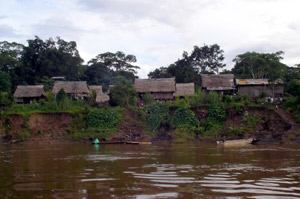|
|
Data gathering |
|
|
|
|
|
| Study sites |
|
|
|
| The field work is carried out along several rivers in the department of Loreto in the Amazon region of Peru. Parts of this area are included in a new Ramsar site called Complejo de humedales del Abanico del río Pastaza that covers more than 3.8 million hectares, centered at 04°00'S 075°25'W. It is an enormous alluvial fan composed of volcanic sediments brought down from the Andes of Ecuador and deposited along the river Pastaza and associated streams and secondary rivers leading to the river Marañon. |
|
 |
|
| The site contains an extraordinary diversity of both permanent and seasonal wetland types, with abundant lakes and remnant islands. Parts of the area near the river Urituyacu are particularly important for the palms Phytelephas tenuicaulis and Aphandra natalia, and the Pastaza supports a large population of the palm Elaeis oleifera, seen only a few places elsewhere in Peru. |
|
| By boat to a transect. Nueve Porvenir, May 2004. |
|
|
|
Human occupation, largely restricted to the banks of the principal rivers, is a low-density mix of indigenous and settler communities who cultivate banana, cassava, and maize (www.ramsar.org). The people are poor and more than half of the children in the school age are malnourished, one third of the population are analfabets, an no one has access to piped water or comunal sanitary systems (Grandez, obs. pers.). Hunting and fishing are important to the nourishment and husbandry is only incipient. |
|
 |
|
| Nueve Porvenir, base of field work. May 2004. |
|
| The forest is largely intact and much of the livelyhood of the population depend on extraction of products for consumption or to a more limited degree for selling. There are several settlements on each of the two rivers. Sixteen on Pastaza river and 14 on Huasaga river. |
|
|
|
|
|
|
|
|
|
|
|

